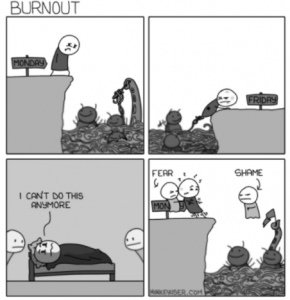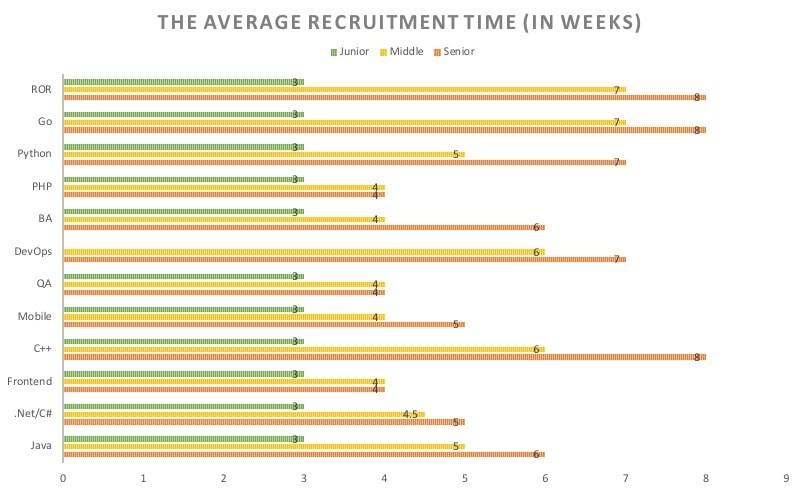
Software developers are not computers. They are fragile human beings with complex emotions who must be cared for in a rapidly changing, technologies-overloaded world. Today we will discover if technologists are happy and healthy and, if not, what can be done about it.
- What is developer burnout?
According to the World Health Organization, burnout is an ‘occupational phenomenon’ recognized by the medical community worldwide and characterized by three dimensions:
- – feelings of energy depletion or exhaustion
- – reduced professional efficacy
- – increased mental distance from a job, feelings of negativism/cynicism related to one’s position (1)
- Are technologists happy or not? Causes, symptoms, and stages of burnout
Our colleagues carried out a small survey of 350 respondents. The results were interesting: 70% of developers were happy at work, while more than 14% were unhappy, and 15% remained indifferent.
The survey also demonstrated that salary (60%), work-life balance (58%), flexibility (52%), productivity (52%), and growth opportunities (49%) are the top five reasons for developers’ happiness. By the way, did you know that the happiest developers live in Spain (90%)?
On the other hand, developers’ unhappiness is driven by a low salary, the absence of a healthy work-life balance, feeling unproductive at work, and limited growth opportunities. (2)

Two additional surveys of British and American CIOs and IT decision-makers (nearly 600 respondents in each) revealed that 83% of software engineers feel burned out at work. The key symptoms are:
- – Loss of passion
- – Physical lethargy/fatigue
- – Mental exhaustion
- – Changing habits
- – Feeling isolated/detached
- – Performance issues (1)
The problem appears to be universal and not restricted by a certain geographical region, income, or occupation. Scientists have been studying the phenomenon of burnout for decades if not centuries (this condition was first described in the Book of Exodus). Herbert Freudenberger, an American psychologist, described the process of ‘burning out’ in 12 stages that were later simplified into five stages:
- 1. Honeymoon phase. No signs of burnout; employees are full of enthusiasm, commitment, and joy from their work. They are productive, creative, optimistic, and full of energy.
- 2. Onset of Stress. People gradually start noticing that some days are more stressful than others. Early signs may include an inability to focus, headaches, anxiety, change in appetite, and even high blood pressure.
- 3. Chronic Stress. Performance and problem-solving skills decrease; people procrastinate; even small things can make them aggressive, resentful, or sad. They may resort to alcohol and drugs.
- 4. Burnout. The feelings of powerlessness, failure, despair, and disillusionment prevail. People may experience constant fatigue, digestive problems, chronic headaches, and possible behavioral changes.
- 5. Habitual Burnout. People always feel sad and depressed as burnout becomes a permanent part of their life. Bringing oneself back to normal life is more challenging than ever before. (3)

If you or someone from your immediate circle experiences burnout, returning them to everyday life as quickly as possible is necessary. Remember: speaking to your local general practitioner or mental health service is the best start in any situation!
- Ways to prevent developer burnout
No one but you can stop the process of burning out, the ‘plague of the 21st century’. To be able to do so, you must know simple tips for avoiding burnout in any professional sphere. Remember: it’s easier to prevent burnout than to treat it with these tips:
- – Organize your workflow
- – Mix different frameworks and technologies up
- – Learn when to say ‘no’
- – Take regular breaks throughout the day
- – Take a ‘proper’ break: longer vacations without your computer
- – Look after yourself (1)

Here are some more ways to prevent developer burnout (applicable to any other sphere of professional interests):
- 1. Find what makes you passionate about engineering
- 2. Request your time off
- 3. Avoid unrealistic goals
- 4. Find a healthy schedule
- 5. Prioritize your well-being
- 6. Change up your tasks
- 7. Offer flexible deadlines (4)
- Developers’ motivation: What can companies do?
The fight against burnout is two-way traffic: individual engineers and companies alike should say ‘no’ to this destructive phenomenon. Here are 13 ways of how psychologically-versed managers can motivate software developers within a team or company:
- 1. Listen to employees. Every person is different: find out what general or specific interests make your developers tick.
- 2. Use new technology. Revamp and modernize old software because maintaining code created long ago on outdated technologies can be frustrating.
- 3. Training. Give developers an opportunity to be appropriately trained so they feel prepared before diving into a new technology.
- 4. Recognition. Make their hard work noticed and appreciated by peers. Expressing gratitude can make for a happy workforce.
- 5. Growth opportunities. Provide developers with opportunities to excel and become leaders within the organization.
- 6. Opportunities to innovate. Encourage software developers to have fun and experiment during hackathons.
- 7. Flexible work hours. Trust developers to get their work done during times when it’s not difficult for them.
- 8. Flexible infrastructure. Establish a work-from-anywhere approach to value employees for their skills, not for their physical presence in the office.
- 9. Empower. Software engineers should be empowered to make independent decisions about their work and figure out how to best implement their goals.
- 10. Simplify and streamline. Streamline the company’s processes and simplify tools so your workforce focuses on the tasks that matter most.
- 11. Surround them with talent. Software developers thrive in environments where they are surrounded by technical talent and professional challenges.
- 12. Play. Developers are big gamers; gamification is big business. Make work fun, and you will get more engaged employees.
- 13. Respect and care about their intelligence, technical aptitude, individualism, and unique talents. (5)
- Recipe of motivation for developers on legacy projects
Developers working on legacy projects may face a lack of motivation and burn out more often than the rest of their professional community. In this section, we want to shine the spotlight on the causes of the lack of motivation and some possible solutions (actually, it’s Sonerim’s know-how). Let’s start with a cooking metaphor.
Everyone loves good old-fashioned dishes, be it a stew, pudding, or omelet. They smell and taste of granny’s kitchen and make you salivate. They are simple and artless, but you do enjoy them, unreasonably and illogically. They are so tasty and remind you of sweet home…
You’ve surely seen the animated film ‘Ratatouille’: an old recipe kept intact immediately transports you to realms of happiness and joy. You can’t change ingredients; they’re simple and few; you can do the only thing to make your business succeed – add a pinch of your dedicated soul.
Legacy projects, especially big-scale, heavy-weight web developments, are similar to such dishes. Young and ambitious programmers are eager to create their own unique encoding. They do not want to waste 90% of their valuable time searching for the right place in a monster-size codebase to insert several lines of supplementary code, with only 10% left for the inception of new features. At the same time, a customer aspires to keep their ‘business-as-usual’ at minimum cost.
Keeping the whole system working is a challenge! Luckily, there is this ‘magic recipe’ consisting of 3 ingredients:
- 1. balance
- 2. purpose
- 3. empowerment to decide
Let’s have a closer look at every ingredient of the magic recipe:
Balance
A smart balance between team stability and challenging tasks is the key point if you want to avoid project cost explosion and keep developers satisfied. Your management has to reconcile the needs of your long-term customers and your staff to remain a reliable partner for both sides.
This balance presupposes:
- – A portion of ongoing, regular tasks (when the customer wants to keep the good old days of the project);
- – A portion of challenging tasks that bring real value in terms of performance, optimizations, and refactoring measures (with clients not so eager to invest in these aspects).
Arranged this way, such tasks instantly become a puzzle when the whole team is engaged in cracking it with fun and excitement!
Purpose
The guideline you must abide by is the following: ‘If there is no purpose, invent it!’ Senseless, routine actions or a lack of global direction and vision are uninspiring to developers and not beneficial for projects.
Understanding corporate needs is not enough; we are created in the way we want to be an integral part of something bigger and better than we are — some grand scheme beyond civilization’s technological and social development. We want to feel we do our humble part to make the world a better place.
Every company should brief its developers on a regular basis, providing in-depth and motivating analysis of the client’s business case, as well as the importance of legacy project maintenance. It’s necessary to demonstrate the potential of a new platform, its large scale, and prospective business influence.
Empowerment to decide
Making decisions about your work is essential for any specialist, especially for a software engineer who is a member of a specific professional caste. Alongside the respect for general policies defined by business leaders, the technical staff should deal with implementation tactics, deciding on items such as coding standards, tools, and design decisions.
Every company should realize that self-managed teams of developers are great partners in company strategy. They suggest changes and improvements to clients, make presentations, and offer performance optimization for outdated platforms.
Conclusion
The best reward for any software development company should be seeing its engineers happy, healthy, and thriving. Suppose a company succeeds in balancing at the cutting edge between stability and innovation and between employees’ health and projects’ completion. In such a scenario, it will be an inexhaustible energy source for further growth, prosperity, and sustainability. Magic, isn’t it?
Sources:
- https://www.jobsity.com/blog/how-to-spot-and-avoid-burnout-as-a-developer
- https://www.dice.com/career-advice/are-software-developers-actually-happy-in-their-current-jobs
- https://vitrueremote.com/blog/5-stages-of-burnout/
- https://fellow.app/blog/productivity/engineering-developer-burnout-symptoms-how-to-prevent-it/
- https://techbeacon.com/app-dev-testing/13-ways-motivate-software-engineers
Additional Articles
-

You already know everything about Sonerim’s history. Now, it’s time to find out a couple of interesting facts about our spirit, that is, our corporate culture, values, structure, and team. Here we go!
-

Are you a solo entrepreneur looking to hire a software developer for your project? It might seem a challenge to attract and review software developers without being a developer yourself. However, if you have a solid hiring strategy, it’s not a problem to find a specialist who will fit the role and the team.
-

Employing a full-fledged software development team may not be possible for start-ups and medium-sized businesses, sometimes even for big enterprises. To overcome a lack of in-house programmers, companies resort to outsourcing software development. Let’s take a closer look at the ever-growing practice of outsourcing and consider its advantages and disadvantages.
Leave a Reply